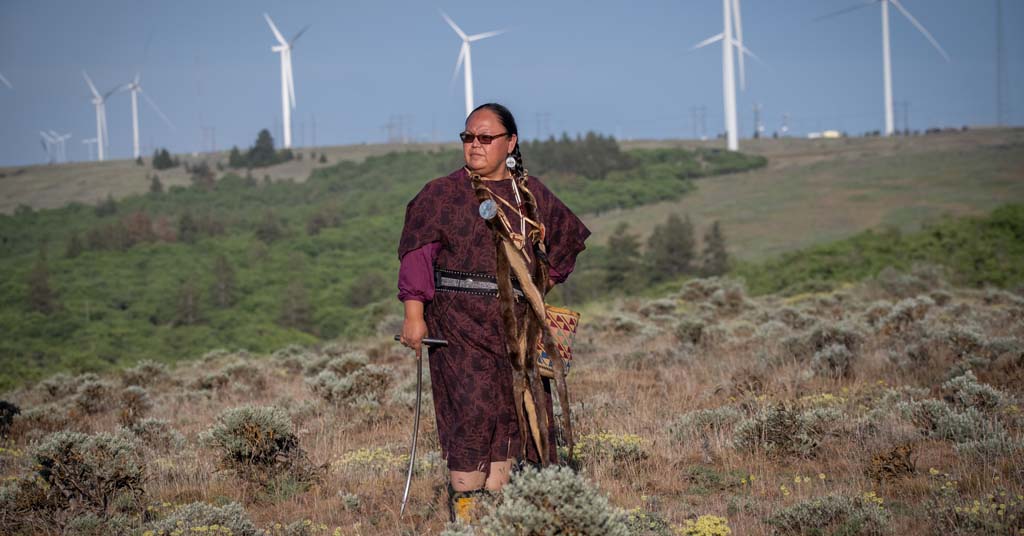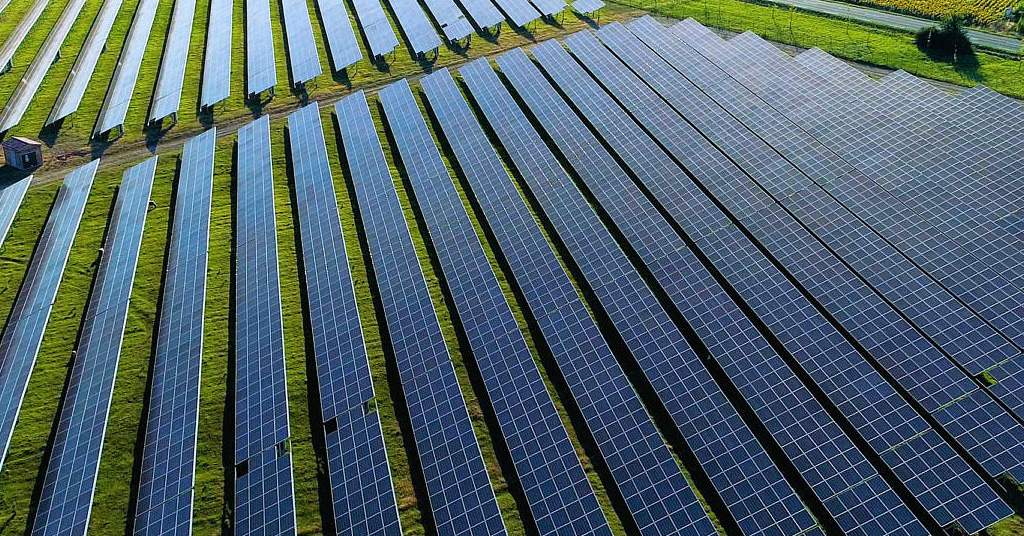Rural landscapes tend to make great settings for renewable power facilities, but would you be willing to live next to one?
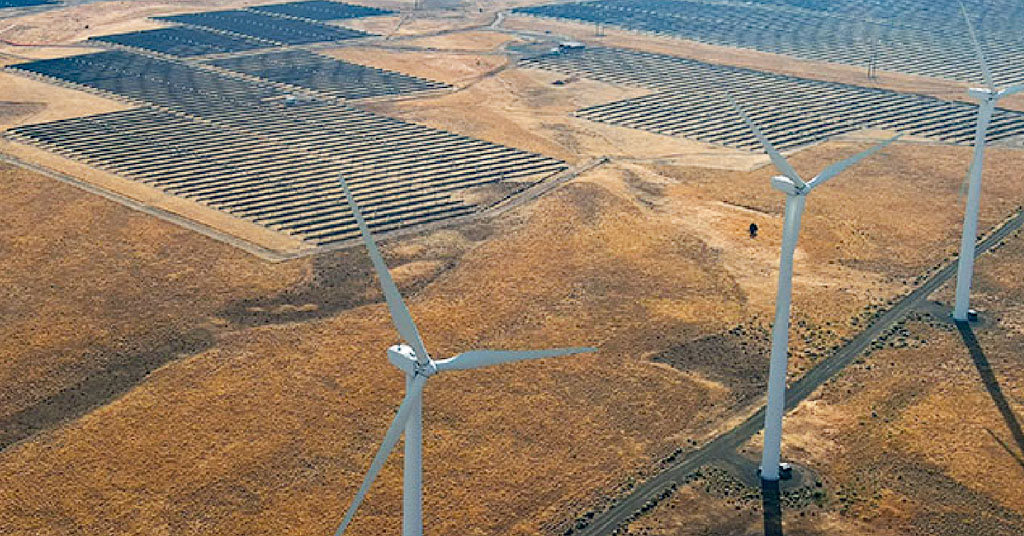
Twisting in the wind: In southwest Washington, Lund Hill is the state’s largest photovoltaic plant, but many rural residents feel government regulators are giving them the cold shoulder. Photo: Iberdrola Group
By Grant Stringer. March 16, 2023. Washington state’s biggest solar farm just went operational, but at the cost of rural resentment that threatens the region’s clean energy revolution.
The Lund Hill solar project occupies about three square miles of windswept steppe in southwest Washington’s Klickitat County.
At a maximum capacity of 150 megawatts, it will generate power for a utility that serves customers outside of the county, mostly in the most populous parts of the state, west of the Cascade Range.
On Feb. 28, Wash. Gov. Jay Inslee issued a statement along with the multinational energy giant behind the project, Iberdrola, celebrating Lund Hill.
Yet that same day, dozens of residents flocked to the county seat of Goldendale, or appeared via Zoom, to tell the Board of County Commissioners in no uncertain terms they have no interest in making room for another such renewable energy facility.
The meeting was sparked by new plant proposals.
A subsidiary of Iberdrola is seeking county permission to build a 100-megawatt solar farm near Lund Hill. Three other developers are also attempting to site commercial solar projects.
Opposition gaining steam
As Columbia Insight reported in 2021, local activists in Klickitat County have fiercely resisted the arrival of solar energy. They say solar modules sully views of bucolic farmland, pose environmental risks and disrupt the area’s agricultural roots.
The activists snagged their first big win in January, when two of the county’s three commissioners approved a temporary ban on new commercial-sized solar developments in some parts of the county.
The commissioners called the Feb. 28 meeting to ask if they should keep the ban and create a citizen-led permitting process that could produce stricter regulation of renewable energy sites.
The answer: a resounding yes.
“I feel like this is a holiday that we should be celebrating,” said Husum resident Cheri Bosquet.
Like most of the testimonies that day, Bosquet urged county officials to stay the course and overhaul the county’s streamlined, but aging approach to energy permitting.
“You guys think it’s just a sage-ground desert—no use. Well, to us it’s important.” —Elaine Harvey
Most speakers who supported the moratorium also said they aren’t opposed to solar energy in general—only projects that would be near their homes.
But other speakers justified leasing their land to energy firms or said the temporary ban would deprive Klickitat County of an opportunity to provide the state with clean energy.
“If not in your backyard, then whose?” said Melody Hill, a homeowner near Goldendale.
The county commissioners are set to decide whether to continue the moratorium at a meeting scheduled for March 21.
Opposition to solar energy isn’t confined to Klickitat County or southwest Washington.
Experts say local opposition to renewable energy projects—sometimes fueled by the oil and gas industry—is contributing to a slowdown of solar and wind projects that threaten national and statewide climate goals.
Pros and cons debated
Along with the massive Lund Hill solar farm, more than 600 wind turbines dot the landscape in Klickitat County. It’s part of a corridor of renewable energy projects largely located east of the Cascade Range in Oregon and Washington, fed by vast tracts of farmland and relatively easy connection to regional transmission lines.
The projects are key to lawmaking efforts in Salem and Olympia to build local sources of renewable energy that aren’t hydropower dams, which have long plagued migrating fish, and drawn opposition from Tribes, environmentalists, anglers and others.
While Klickitat County is no stranger to large wind power installations, the recent interest in the county from solar developers has kicked off a heated debate about the pros and cons of industrial-scale renewable energy facilities.
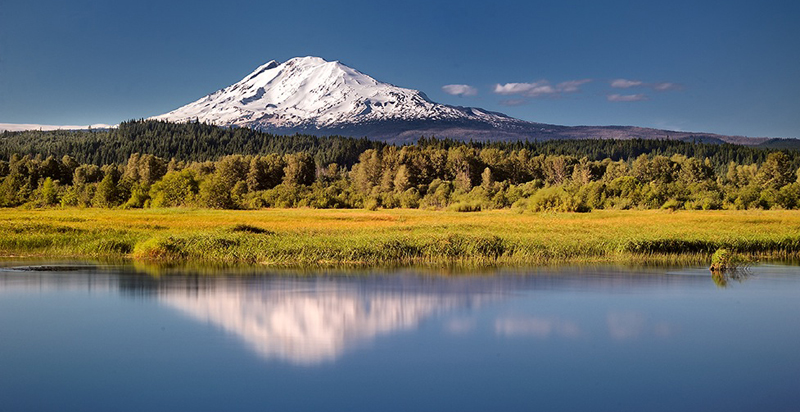
Mount Adams: These are the kind of views many people come to Klickitat County for. Photo: Gary Dee/Wikimedia Commons
On the ground, the economic benefits of wind and solar are mostly limited to local government tax coffers and payouts to landowners who lease or sell their land to developers.
After construction, a proposed 63-megawatt solar project in Klickitat County would provide only a few jobs, according to an analysis paid for by the developer.
Dave McClure, the county director of economic development, says the tax revenue has tangible benefits. In 2010, the small Klickitat County community of Bickleton relied on wind farm revenues to replace a 50-year-old school. In 2020, the county’s top 15 taxpayers included nine wind projects that together accounted for about $7 million, according to McClure.
Renewables projects can also provide stable income for farmers and ranchers amid price volatility and the seasonal chaos unleashed by climate change.
One land owner, Jim Hill, told the county commission on Feb. 28 why he’s letting developer Cypress Creek Renewables build part of the proposed 63-megawatt solar installation on his land.
“Our (property) values are going sky high,” said Hill.
Construction would kick off early next year if state regulators approve it.
But much of the local opposition has galvanized around the development, called Carriger Solar.
Testy project
Cypress Creek wants to build the Carriger Solar installation on more than 1,300 acres of farm and ranchland west of Goldendale. It would be surrounded by a six- to eight-foot-tall fence topped with barbed wire.
The solar modules would track the sun and reach a maximum height of 12 feet, according to the company’s application. The developer also plans to build a substation to transfer the power and two acres of lithium-ion batteries for storage.
Greg Wagner, a retired journeyman electrician, would live on the solar farm’s doorstep.
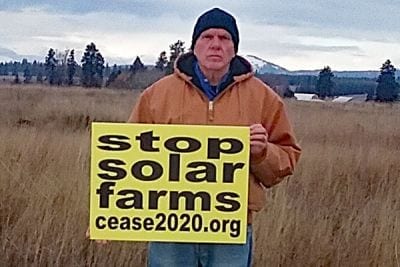
Broad view: CEASE founder Greg Wagner is a leader of solar opposition in Klickitat County. Photo: CEASE
Wagner is among the most vocal critics of the renewable energy developers, who he called “ruthless” and “dishonest” during the commission meeting.
With his wife, Debbie, Wagner leads Citizens Educated About Solar Energy, or CEASE, to fight for a steady moratorium and new regulations. About 200 people have joined the group’s Facebook page.
Wagner’s property bounds fields of dryland wheat and hay, and from his home, he can see three of the Pacific Northwest’s volcanic peaks—Mount St. Helens, Mount Adams and Mount Hood.
“I love it out here, and that can all be destroyed,” he says.
He’s horrified by reports of lithium battery fires and says they’d put communities at risk, especially if severe wildfires reach Goldendale.
He also cites a University of Texas study in which some homeowners reported nearby solar arrays diminished their property values, with worse impacts near larger solar farms.
Wagner and others also have a slew of environmental concerns.
Elaine Harvey, a Yakama Nation Tribal Member and an environmental coordinator for the tribe’s fisheries division, told commissioners that solar projects disrupt wildlife and other cultural resources her nation depends on. She chided county officials for facilitating the developments.
“You guys think it’s just a sage-ground desert—no use. Well, to us it’s important,” she said.
In its Carriger Solar application, Cypress Creek details plans to create corridors for wildlife migration and build around wetlands, pools or streams.
Harvey does say she’s deeply concerned about climate change. And Wagner has said that he’s not outright opposed to solar energy. But in an interview with Columbia Insight, he cast doubt on the technology’s feasibility and the scientific consensus that humans are causing profound damage to the earth’s climate.
“The whole premise that CO2 is the problem; it’s not the problem,” he said.
Wagner also said that CEASE doesn’t receive any guidance or resources from outside groups.
National ‘impediment’ to climate goals
Local opposition to the Carriger Solar project, and others, may not matter much in the short term.
Cypress Creek submitted its application through the state government’s parallel permitting process, which is generally more favorable to developers than to county residents.
And the county moratorium doesn’t apply to Iberdrola’s application for the 100-megawatt installation, which the company already submitted.
But far beyond Klickitat County, it’s become common for locals to oppose solar farms and wind turbines.
In Ohio, for instance, a 2021 state law gave local governments veto power over renewable energy projects, an option that doesn’t exist for fossil fuel developments, according to the Ohio Capital Journal.
In southern Oregon’s Klamath County, local opposition forced developer Hecate Energy to withdraw and tweak a proposal for a 150- to 300-megawatt solar farm.
A Columbia Law School analysis found last year that “local opposition to renewable energy facilities is widespread and growing, and represents a potentially significant impediment to achievement of climate goals.”





